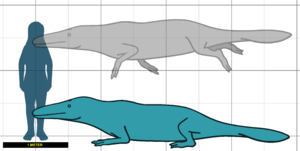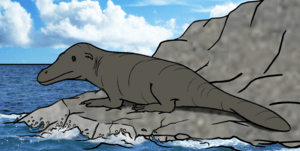Peregocetus facts for kids
Quick facts for kids Peregocetus |
|
|---|---|
 |
|
| Size silhouette of Peregocetus compared to a human. | |
| Scientific classification |
|
| Kingdom: | Animalia |
| Phylum: | Chordata |
| Class: | Mammalia |
| Order: | Artiodactyla |
| Infraorder: | Cetacea |
| Family: | †Protocetidae |
| Subfamily: | †Protocetinae |
| Genus: | †Peregocetus Lambert et al., 2019 |
| Species | |
|
|
Peregocetus was an ancient type of whale that lived a very long time ago. It lived during the Eocene epoch, about 42.6 million years ago. Its home was in the area we now call Peru, in South America.
Scientists found its fossil in 2011. A team from several countries, including Belgium and Peru, discovered it. They found parts like its jaw, legs, spine, and tail. This discovery was very important. It helped scientists learn more about how whales changed over time. It also showed how they spread across the world.
Peregocetus was special because it was the first four-legged whale found in the Pacific Ocean. It was also the first found in the Southern Hemisphere. This means these early whales, called protocetids, traveled far. They could walk on land and swim in the ocean.
What Peregocetus Looked Like
Imagine a whale with four legs! That's what Peregocetus was like. It had webbed feet, which helped it swim. But it also had small hooves on its toes. This made it good at moving around on land, much like a modern seal.
Peregocetus had sharp teeth and a long nose. Scientists think it probably ate fish or small sea creatures like crustaceans. Its tail bones suggest it might have had a flat tail. This would be similar to a beaver's tail, which helps them swim.
See also
 In Spanish: Peregocetus para niños
In Spanish: Peregocetus para niños


